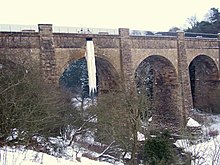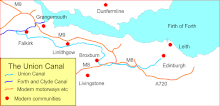Union Canal (Scotland)

The Union Canal, full name the Edinburgh and Glasgow Union Canal, is a canal in Scotland, running from
It has benefited from a general revival of interest in canals and, as a result of the Millennium Link, was reopened in 2001 and reconnected to the Forth and Clyde Canal in 2002 by the Falkirk Wheel. It is now in popular use for leisure purposes.


History
Union Canal | ||||||||||||||||||||||||||||||||||||||||||||||||||||||||||||||||||||||||||||||||||||||||||||||||||||||||||||||||||||||||||||||||||||||||||||||||||||||||||||||||||||||||||||||||||||||||||||||||||||||||||||||||||||||||||||||||||||||||||||||||||||||||||||
|---|---|---|---|---|---|---|---|---|---|---|---|---|---|---|---|---|---|---|---|---|---|---|---|---|---|---|---|---|---|---|---|---|---|---|---|---|---|---|---|---|---|---|---|---|---|---|---|---|---|---|---|---|---|---|---|---|---|---|---|---|---|---|---|---|---|---|---|---|---|---|---|---|---|---|---|---|---|---|---|---|---|---|---|---|---|---|---|---|---|---|---|---|---|---|---|---|---|---|---|---|---|---|---|---|---|---|---|---|---|---|---|---|---|---|---|---|---|---|---|---|---|---|---|---|---|---|---|---|---|---|---|---|---|---|---|---|---|---|---|---|---|---|---|---|---|---|---|---|---|---|---|---|---|---|---|---|---|---|---|---|---|---|---|---|---|---|---|---|---|---|---|---|---|---|---|---|---|---|---|---|---|---|---|---|---|---|---|---|---|---|---|---|---|---|---|---|---|---|---|---|---|---|---|---|---|---|---|---|---|---|---|---|---|---|---|---|---|---|---|---|---|---|---|---|---|---|---|---|---|---|---|---|---|---|---|---|---|---|---|---|---|---|---|---|---|---|---|---|---|---|---|---|
| ||||||||||||||||||||||||||||||||||||||||||||||||||||||||||||||||||||||||||||||||||||||||||||||||||||||||||||||||||||||||||||||||||||||||||||||||||||||||||||||||||||||||||||||||||||||||||||||||||||||||||||||||||||||||||||||||||||||||||||||||||||||||||||
Proposal
The canal was conceived with the purpose of moving minerals from the mines and quarries in Lanarkshire to Edinburgh.
In 1817, the Edinburgh and Glasgow Union Canal Company obtained a
The primary object of this navigation was to effect an inland communication between the cities of Edinburgh and Glasgow; to the former of which it must be essentially serviceable, in consequence of the increased facilities afforded to the transit of lime, coal, stone, &c. which abound in its course.
This undertaking was designed by Mr.
Lothian Road, near the city of Edinburgh, to join the Forth and Clyde Navigation near Falkirk, in the county of Stirling.' The company of proprietors consisted, at the time the first act was obtained, of three hundred and eighty-four persons, amongst whom were the Lord Provost of Edinburgh, Sir William Forbes, Sir John Hay, and Sir John Marjoribanks, who were incorporated by the name of "The Edinburgh and Glasgow Union Canal Company," with power to raise £240,500, in four thousand eight hundred and ten shares, of £50 each, and a further sum of £50,000, either among themselves, by the admission of new subscribers, or on mortgage of the undertaking.[1]
The estimate of cost was evidently inadequate because a second Act authorised the borrowing of £48,100, a third Act of 1821 authorised an increase in share capital of a further £50,000 and a fourth authorised a further £60,000.[1]
However, when the Union Canal got its Act, the town of Linlithgow, along with Edinburgh, mounted a legal petition for compensation for any losses they would incur from the turnpike that ran between Glasgow and Edinburgh. Their writ read:
The Company are directed to indemnify the Magistrates and Town Council of the Royal Burgh of Linlithgow for any Diminution of the Customs upon Cattle, Carriages, or Goods carried over the Avon at Torphichan Mill; also to secure to the Magistrates and Town Council of the City of Edinburgh the Rate of One Penny per Ton on all Goods, Wares, or other Things (except Manure,) shipped or unloaded at any of the Wharfs and Basins, in lieu of certain Rates, Dues, Causeway, Mail, and Petty Customs, which they are now entitled to; as it appears that, by a Charter or Gift of Charles the First, dated 17 May 1636, the Ministers of Edinburgh are entitled to a Duty or Custom of Thirteen Shillings and Four-pence Scots, upon each Ton or Pack of Goods imported to Edinburgh, Leith, or Newhaven. The Company are therefore directed to pay the same on all Goods which may be imported by this Navigation. They are also bound to indemnify the Edinburgh Road Trustees, the Bathgate, and another Trust, in any Diminution of Tolls arising from these Turnpike Roads, which may be affected by their Canal.[1]
Construction & design

The Union Canal, which has a length of 31 miles (50 km) today, was built as a
The canal has several navigable aqueducts, including the Slateford Aqueduct that takes the canal over the Water of Leith in Edinburgh, the Almond Aqueduct near Ratho and the 810-foot-long (250 m) Avon Aqueduct near Linlithgow, the second-longest in the United Kingdom. Priestley describes the route and structures in some detail:
[The] Canal commences from the sixteenth lock of the Forth and Clyde Navigation, about two miles west of Falkirk, in the county of Sterling [
Lothian Road, about half a mile [0.8 km] south-west of the castle. The length of the canal is thirty miles [48 km], the depth of water 5 feet [1.5 m], and is on one level from Edinburgh to its western extremity, where it falls 110 feet [34 m], in one series of locks, into the Forth and Clyde Canal.[1]
Many of the stone bridges have
The income from the project was derived from tolls, and charges for
Closure and demise

In 1842 the
However, after a campaign was started by groups and local communities to improve the canal, work was carried out to restore the network during the 1990s. This culminated with the millennium project to reinstate the link between the Union Canal to the Forth and Clyde Canal with a boat lift called the Falkirk Wheel.
Archaeology


In 2004, an archaeological investigation by a team from Headland Archaeology uncovered the stern of a 21-metre-long (69 ft) wooden barge.[3] The vessel was discovered on the south bank of the canal between the Leamington Lift Bridge and Viewforth Bridge in Edinburgh. The remains represent the final berth of an early- to mid-19th-century canal barge or scow, a type of horse-drawn vessel that was the main freight carrier of the time. Typical cargoes included coal and lime from Lanarkshire, although there were a number of passenger carriers too; the actual function of this vessel is unknown. The vessel was dismantled and removed from the canal in order to record the techniques used in its construction. Additional work will seek to identify the species, age and provenance of the timbers.
Millennium Link
The Millennium Link was a project to restore a link between the Union and Forth and Clyde Canals at the Falkirk end. In 2002 the
Leisure uses

The canal is now used recreationally by
Edinburgh Quay is a major regeneration project centred on the site of Lochrin Basin, in the heart of Scotland's capital. It provides around 90 waterfront apartments, 150,000 square feet (14,000 m2) of offices and 55,000 square feet (5,100 m2) of retail and restaurant space.[4]
Raft races have become an annual event, having been held in Edinburgh from 2007 to 2011, and using found "junk" material for the rafts. The Linlithgow Union Canal Society has been hosting its cardboard boat race for many years at Linlithgow Basin.
2020 Canal Breach
In the early morning of Wednesday the 12th of August 2020, slow-moving thunderstorms caused torrential rain over much of eastern Scotland, including in the Falkirk area. This heavy rainfall caused the Union Canal to overtop its embankment east of Polmont, producing a 30 metre wide breach in the canal.[5] The floodwaters released from the breach caused significant damage to the main railway line from Glasgow to Edinburgh via Falkirk High, Scotland's busiest railway line.[6]
See also
- Canals of the United Kingdom
- Falkirk Helix
- Falkirk Wheel
- Forth to Firth Canal Pathway
- History of the British canal system
- John Muir Way
- St Kentigern's Church, Edinburgh (Union Canal)
- History of the Union Canal, archived from www.scottishcanals.co.uk
Bibliography
- Cadell, H.M. (1923). "Scottish canals and waterways". Scottish Geographical Magazine. 39 (2): 73–99. .
- Coleman, R (2004). Union Canal, Leamington Wharf. Discovery and Excavation in Scotland. p. 57.
- Lindsey, Jean (1968). The Canals of Scotland. David & Charles Publishers. ISBN 0-7153-4240-1.
- Massey, Alison (1983). The Edinburgh and Glasgow Union Canal. Falkirk Museums Publication. ISBN 0-906586-24-0.
- Paterson, Len (2005). From Sea To Sea: A History of the Scottish Lowland and Highland Canals. Glasgow: Neil Wilson Publishing. ISBN 1903238943.
- Priestley, Joseph (1831). Historical Account of the Navigable Rivers, Canals and Railways of Great Britain. London: Longman, Rees Orme, Brown and Green.
References
- ^ a b c d Priestley 1831, pp. 230–233
- ^ "Union Canal". Scottish Canals. Archived from the original on 15 June 2018. Retrieved 15 June 2018.
- ^ "RCAHMS - Royal Commission on the Ancient and Historical Monuments of Scotland". Canmore.rcahms.gov.uk. Archived from the original on 6 October 2011. Retrieved 20 June 2012.
- ^ "History of the Union Canal". Scottish Canals. Archived from the original on 15 October 2012.
- ^ "Storm leaves giant hole in Union Canal". BBC News. 13 August 2020. Archived from the original on 13 November 2020. Retrieved 18 August 2020.
- ^ "'Two months' to repair flood-damaged rail line". BBC News. 18 August 2020. Archived from the original on 7 October 2020. Retrieved 18 August 2020.
